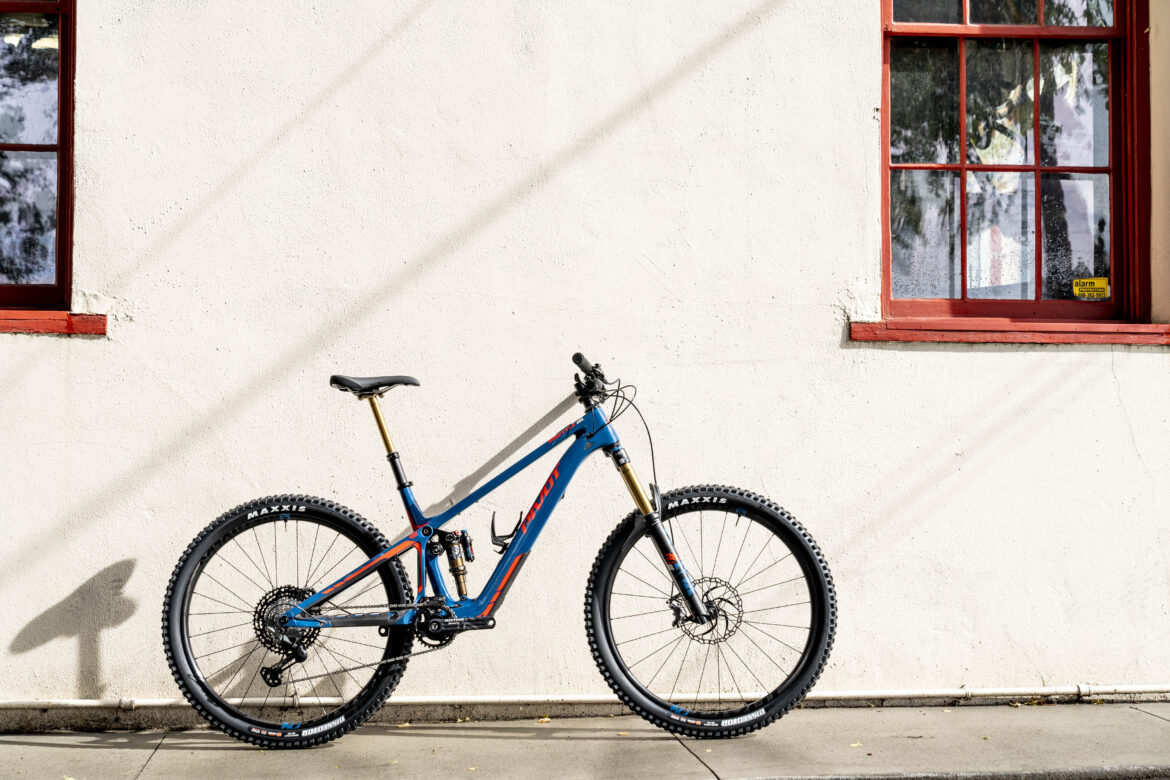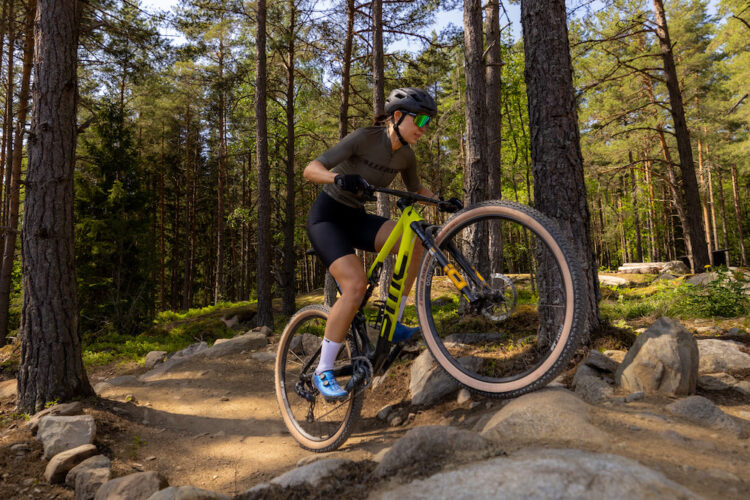
What’s the point of lightweight eMTBs anyway, I wondered into text just six or seven months ago. The real question was, why not just opt for a full-powered and full-weighted eMTB, when the weight doesn’t really matter anymore?
At a press event for Pivot where we were invited to experience their newest long travel Shuttle LT e-bike and mid-travel, lightweight Shuttle SL e-bike, I hoped to find out. I’ve ridden a few hefty, long travel e-bikes, and I like the planted feel, long battery life, and power of the larger motors, but this Pivot Shuttle SL ride would be my first experience with anything in the same category as the Orbea Rise, or Trek Fuel EXe. Sure there’s the Specialized Turbo Levo SL, but that bike seemed to sit right in the middle, and its light weight was achieved partly through lighter components than it should have been specced with at the time.
What’s different about this new crop? The Rise, Fuel EXe, and now the Shuttle SL look very unassuming. They have sleeker, quieter motors, slimmer downtubes and batteries, great component specs, and are lighter than ever. The Pivot Shuttle SL has 132mm of rear travel and either a 140mm or 150mm fork.
About the Pivot Shuttle SL

For the new Shuttle SL, with builds that weigh as little as 36.25lbs, Pivot partnered with Fazua to use their new Ride 60 motor. The German brand Fazua is relatively new to the U.S. market, and Pivot became an early launch partner for the bike, though their first partnership was actually on the E-Vault gravel bike which launched in 2020.
The Ride 60 has 60Nm of torque and a max power of 450W. The motor weighs 1.96kg. The battery weighs 1.1kg and has a 430Wh capacity — much smaller than the LT — but with a lighter weight, you don’t need as much power.
A lot of e-bikes, considering many use Shimano’s EP8 system, operate similarly with an up/down controller, but Fazua has a fresh perspective with their Ring Control remote. The Ring Control works like an up/down lever with the mode selector rotating up or down the ring to turn the bike on, select one of three power modes, or get a quick boost of power.
If you’re a new e-bike motor company there’s no point in being exactly like everyone else. Fazua names their three modes Breeze, River, and Rocket. Breeze is like a tailwind and River is “progressive and very athletic,” responding to the rider’s power input and putting out more power when you need it. Rocket is the most powerful mode. Riders can also access a Boost mode at any power level by pushing the Ring Control up for four seconds. Then, the Ride 60 enters a ten second burst of power.

These modes are all tunable in the Fazua app and the bikes receive updates through the app too. The motor has bluetooth and ANT+ connectivity. Rider support is available through QBP in Minnesota.
On the suspension front, Pivot says the DW-Link on the Shuttle SL has been dialed to eliminate pedal bob during hard pedaling efforts. The Shuttle SL uses Pivot’s vertical shock orientation for a more compact frame design, better water bottle clearance, and a low standover height.
The lightest World Cup build uses a 140mm Fox 34 Factory fork while the Ride and Pro builds use a 150mm Fox 36.
Pivot said they wanted the Shuttle LS to feel like their Trail 429 with a lightweight responsive feel that is quick and agile, and a feeling that parallels analog mountain bikes.
The geometry in its low bottom bracket setting starts with a 65° head tube angle and a 76° seat tube angle, a low standover height, and fairly lengthy reach and wheelbase. For a medium, the reach is 465mm and the wheelbase is 1,223mm.
The wheelbase is quite a bit longer than the Trail 429 and the head tube angle is slacker, but the reach is similar. While the Trail 429 might have inspired the Pivot Shuttle SL, it seems to borrow some inspiration in the form of stability and aggressiveness from the Switchblade too.
Pivot Shuttle SL ride impressions

We had the opportunity to try out the Shuttle SL on a section of the Monarch Crest route known as the Rainbow Trail. It’s fast and flowy, with a little bit of tech here and there, perfect for a mid-travel bike like the Shuttle SL.
The look and feel of the Shuttle SL is on par with other Pivots. It’s light — for an e-bike — and it has that bomber straight line appearance where the head tube drops right into the top tube and then down to the rear axle. Without any power button on the top tube, I examined the bike and the cockpit trying to find where I might turn the bike on.
Being all too familiar with bike lights and phones and other sorts of electronics it came to me. Push the ring control up for a few seconds and the bike came to life.
We had a sustained service road climb for a while before reaching the start of Rainbow. The SL carries itself well on climbs like this and I had a fast, steady pace steaming up the service road. There is an apparent sensation when the Ride 60 motor kicks on. It’s not harsh or clunky, but it didn’t feel as seamless as the Shimano system we rode the previous day on the Shuttle LT.
The Ride 60 is very quiet though and blends in with the SL, disguising its pedal-assisted intentions.
On steep climbs, the Ride 60 didn’t match the power of the Shimano EP8 I rode the day earlier either. Rocket mode puts you in a solid position to tackle steeps, and Fazua said the power output could be tweaked at the expense of the battery, but even on the heavier bike, I felt I had more power at my disposal for challenging climbs.
The Boost mode however does make for a fun way to tackle climbs. If you see a hill ahead, and use the Boost mode, it provides ten seconds of maximum power for uphill sprints.
Climbing on the SL feels as breezy as the Trail 429 though. The rear suspension keeps the rider up high and doesn’t get bogged down in its suspension under power.

For much of my time on the SL that day, it was easy to forget I was on an e-bike. The handling matches an analog bike, and the weight does too. For the most part, the SL carries itself like a non-motorized bike. On a couple of hairier sections of the Rainbow trail with high-speed chunk and steep rock gardens, the SL charged ahead without flinching. The bike gets up to speed quickly, holds it, and rails turns.
At the end of our 20-mile ride, I had about 60% battery life left. The SL ate through battery life more quickly than the LT, but there is still a lot of life for big adventures and Fazua should have a range extender available for the bike soon.
Issues with the Fazua Ride 60

Unfortunately, quite a few riders in our group that day suffered issues with the Ride 60. It started with sticky Ring Controls. Pressing the remote up, the little lever would stick slightly in that position. While it was a small annoyance during our day of testing, Pivot said they were able to remove a washer that interfered with the Ring’s rebound into position.
The second most noticeable thing, and one that could quickly be resolved too, was a delay in the motor. Coming down and out of drainages was where I noticed the delay. I wasn’t pedaling going down into the drainage, but then pedaling back up the trail into a technical climb, the motor felt like it took up to two seconds to kick on. This isn’t long, but when you expect the bike to ride seamlessly, and you’re pedaling a 38lb bike up a technical climb, it takes some unexpected muscle.
Pivot said they are waiting on Fazua to launch a firmware update available the first week of October which would eliminate the issue. Shuttle SL buyers can have their local dealer update the bike.

The most unfortunate event though was when several of our motors randomly shut off and wouldn’t turn back on immediately. There didn’t appear to be any rhyme or reason as to why the Ride 60 did this. The folks at Pivot and Fazua were upset and frustrated, and worked urgently to resolve the issue. Pivot cares a lot about the quality of their bikes and this was a peculiar hiccup considering the timing. Pivot said they have been testing the bikes for months without issue.
This ride took place at the end of August and I recently reached out to Pivot before press time for an update. Chris Cocalis said a firmware update should be available on October 7 to resolve the issue. The team found the battery went “into a deep sleep” and wouldn’t wake up, and that supposedly unplugging the battery and plugging it back in would help, but it shouldn’t be an issue after October 7.
Unfortunate as the issues may be, Pivot and Fazua were deeply concerned with correcting them as quickly as possible and it seems they were able to get them sorted out.
Who’s it for?
At the end of the press camp, we asked ourselves if we would choose the Shuttle LT or SL. I really enjoyed the SL and it’s an exciting bike because it shows that e-bikes are evolving really quickly. They’re getting lighter and the geometry is correcting itself. The bikes are getting very close to analog bikes in terms of handling and weight and bikes like the LT might be too much for some. The tongue in cheek tagline for the LT is “too much is just right,” but for some, too much might be too much.
I’m in the LT camp though, and at the end of the day, long travel e-bikes with the power to skip a lift or a ride to the top of a gnarly trail is what I like. After all, it is a Shuttle.
But for folks who want a premium e-bike for trail use and aren’t into gnarly downhills and ride a mix of everything, the Pivot Shuttle SL seems to be a great bike.
Closing thoughts

The Pivot Shuttle SL is an exciting development for the future of e-bikes. The power assist from the Fazua Ride 60 is subtle and smooth and the Shuttle SL feels similar to Pivot’s trail bikes; light, stiff, fast, and confident. Folks looking for a great all-arounder of a trail e-bike won’t be disappointed.
Party laps
- Agile and quick handling
- Feels like an analog bike on descents
- Barely looks like an e-bike
Pros and cons of the Pivot Shuttle SL
Dirt naps
- Not as powerful as a larger e-bike






Nice review! So, did the software fix go through…It’s 10/10/22?
Update…called Pivot and spoke with Tom. He said update confirmed.👍 I like the SL weight but want the 150/160 rear travel before I’d commit to selling of my Trek Rail. TBH the forthcoming Transition Relay Fazua 60 may be the Enduro mid-power sweet spot for a 40 lb shredder that I’ll drop 8-10 k 💸 for.🤟🍻